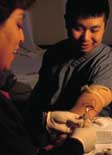 Connecting
the dots "With this technology, we can get a snapshot of everything happening within the cell and assess how all the proteins are interacting with one another," said Hawkes. "We get thousands of results at once, as opposed to one gene and one pathway." The result, he hopes, will be a database of how nutrients interact with the human genome which brings Hawkes back to his original research. "Why give people selenium, which is potentially toxic, when you might get the same effect using vitamins C and E?" Hawkes says. "We can't answer that now because we don't know how these nutrients interact with each other during cancer development." With help from the UC Davis Cancer Center and Lawrence Livermore National Laboratory, the answer may be in sight.
Home |
Table of Contents |
To our Readers |
Building on Basics UC Davis Health System | © 2000, 2001, 2002 UC Regents. All rights reserved. |
 |

